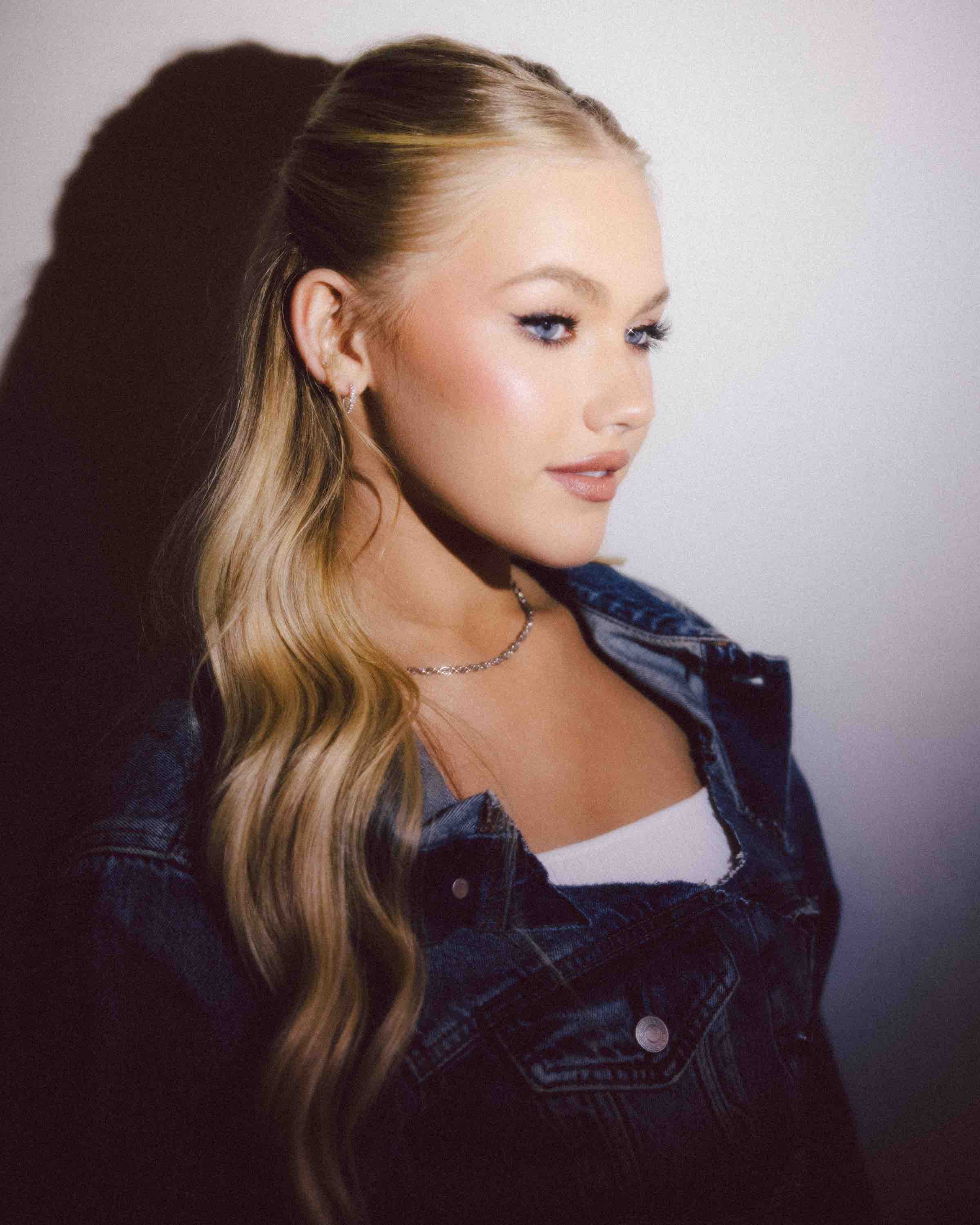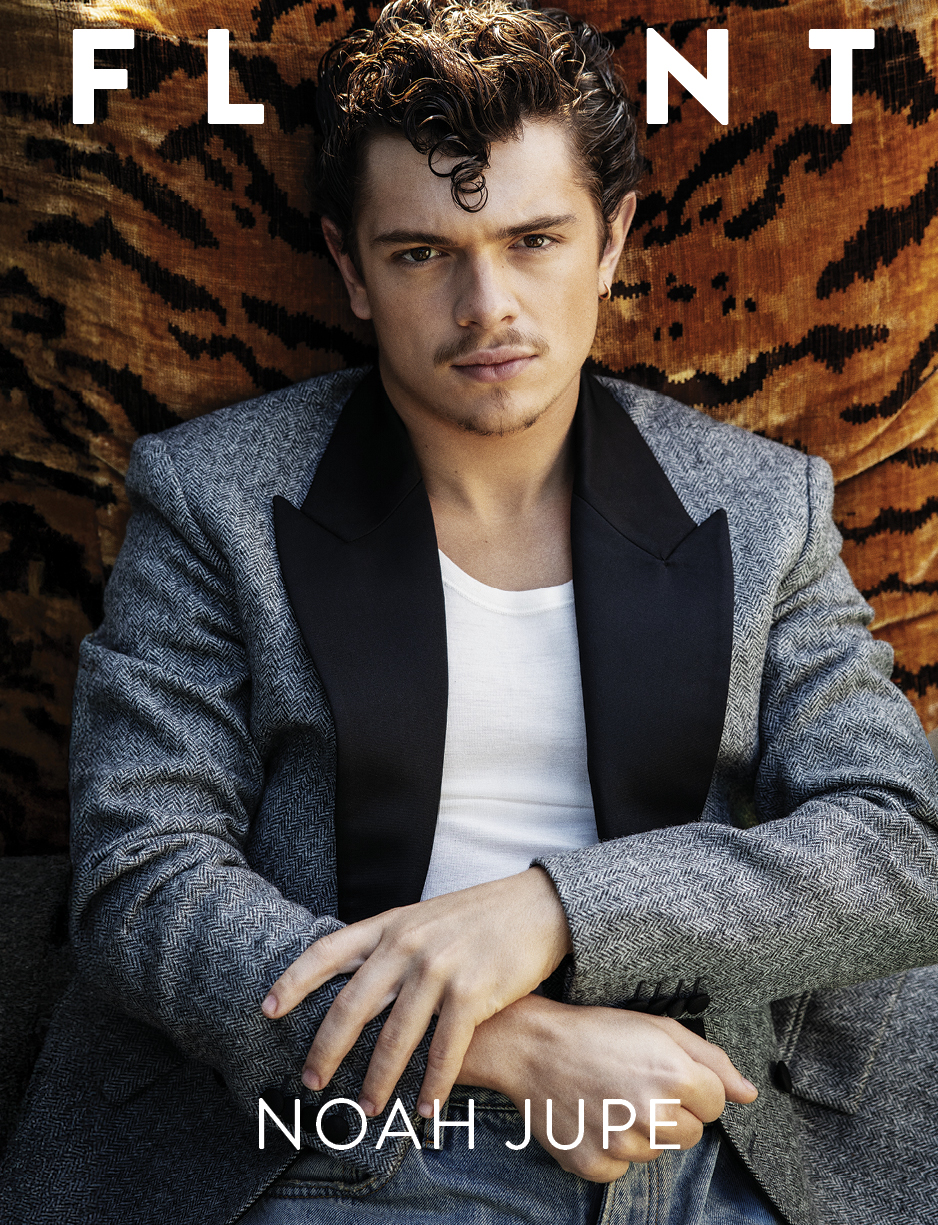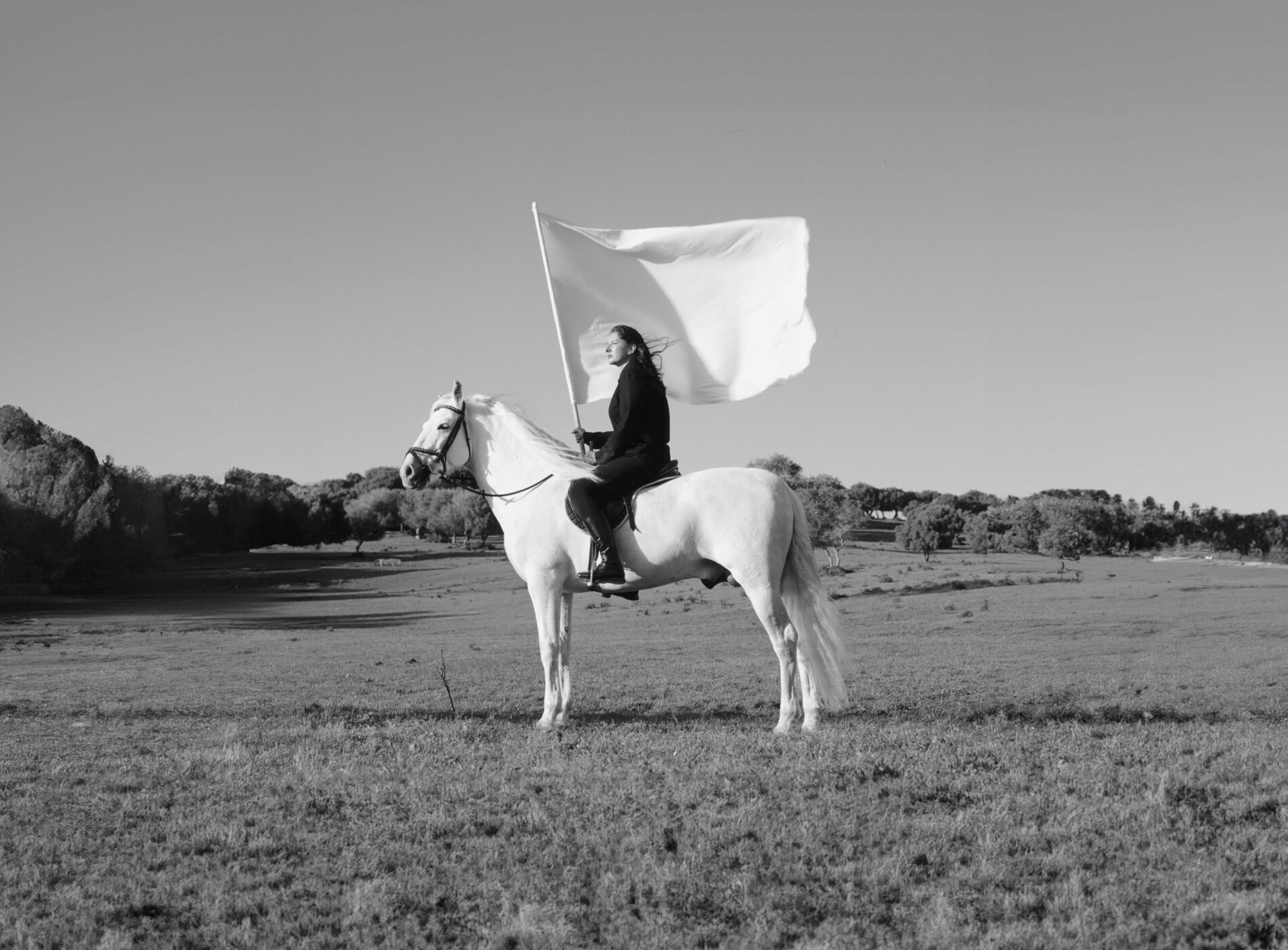

[**LOUIS VUITTON**](https://www.louisvuitton.com) suit and shirt.
Still pictures don’ t do justice to Jon Batiste. He’s a man in constant motion, especially when music’s on, though one gets the sense that music is always playing in his head. He steps in time and turns to the rhythm, occasionally singing the notes of a particularly sweet lick, commenting on what’s playing (“Ooh, Miles! That’s the sound Miles gets after ‘Trane plays—he adds a few more notes”) or just enthusiastically hooting in approval. His energy is infectious: even the tone-deaf among us find ourselves grooving and singing along. “I must have forgotten to take my vitamins,” someone says, “because this guy is wearing me out. You didn’t even have coffee this morning, did you?” Batiste shakes his head and points to the stereo. Music’s all he needs.
Batiste’s artistic output is also in constant motion, as varied as it is prolific. Aside from his nightly duties as the bandleader and musical director of The Late Show with Stephen Colbert, he is also the musical director of The Atlantic and the creative director of the National Jazz Museum in Harlem. Recently, he hosted an edition of NPR’s “Live from Here,” and last year, he released a solo album, Hollywood Africans, plus he’s currently writing a musical based on the life and work of Jean-Michel Basquiat. On top of all that, he regularly performs at a wide range of venues, from the classic, intimate Village Vanguard to the enormous, brand-new Shed at Hudson Yards, where he led a marching band in the inaugural show as part of the “Soundtrack of America” series on April 5.
A few days before the show at the Shed, his excitement is palpable. “The music is going to celebrate the Harlem Hellfighters,” he explains, referring to the African American infantry unit that spent more time than any other in the frontline trenches of World War I. They suffered more casualties than any other unit, too. To keep morale up, the Hellfighters relied on their marching band, which went on to become one of the most famous military bands in Europe, introducing an unfamiliar American style of music—jazz—to Britain and France. “That’s really important to me,” Batiste says, “to commemorate 100 years after they’ve come back from the war. I feel tied to that lineage—all black music, all American music, all music across the world.


[**DIOR MEN**](https://www.dior.com/en_us/mens-fashion/clothing/all-clothing) suit.
When Batiste says, “all music,” he means all music. When his cover of Tupac’s “Changes” comes on, he mentions that he has a rap album that’s “about 60 percent” complete. Mention is made of an in-progress reggae record as well, along with two symphonies, one of which is finished and likely to premiere this year. But for all his branching-out, Batiste’s roots are firmly in jazz. While talking about why he admires Quincy Jones, who recruited him for the Soundtrack of America, he could as easily be talking about himself: “He’s somebody who came from jazz and used jazz to inform everything that he did. From film scoring to writing symphonic work to composing for television to doing pop records to doing R&B records to doing hip-hop records, he shows the power of understanding your craft.” Then a photographer puts up a yellow backdrop, and Batiste announces that he needs to put on a “yellow song.” He chooses “Rio” by Duran Duran.
This expansive mindset is part of what draws Batiste to Basquiat, whose estate asked him to write a musical based on the artist’s life. “It’s influenced by the art,” he says of the workin-progress, “which is such a synthesis of disparate influences. You think about Basquiat, and he’d have the TV on, the newspaper open, magazines, radio playing, people coming in and out, hearing conversations, putting all these different things in the thing he was working on at the moment. It’s almost like there’s a cryptic message in every piece, and so many layers of paint, paintings behind paintings. That’s the approach with the music. When people hear it it’s going knock them back in their seats.”
He continues, saying Basquiat is “an inspiration and a cautionary tale. He was known for saying, ‘All young kings get their heads cut off.’ Which is… kind of true. You see where he’s coming from. He’s an inspiration in the sense that he was able to endure so much without really having a strong support system, yet was still able to create transcendent art and represent the culture and the lineage in such an original way. But you have to be able to preserve yourself. And I relate to that in the sense of constant demands on your time and your vanities, mining you. You have to really understand how to find the humanity in that.”


[**DIOR MEN**](https://www.dior.com/en_us/mens-fashion/clothing/all-clothing) suit.
_Hollywood Africans_ is the title of a Basquiat painting as well as Batiste’s latest album, his first solo effort. The music is simple, pared-down, almost uncharacteristically so for Batiste, who is known for his “love riots,” where he and his band, Stay Human, play raucous impromptu shows in the streets. But the style of Hollywood Africans, Batiste says, is “A way to get back to basics, something I think is of value, and that is missing in this time. We don’t have a lot of just raw, real expression.” Of the recording process: “It was quick. Very much a stream-ofconsciousness. We did two and a half sessions in New Orleans in the middle of a church that was pitch-black, just me and the piano and the microphone. And then we came back to New York and did two more sessions. The record was 80 percent there after the New Orleans sessions, but I felt like times changed and that the world needed some music like that.”
The album was produced by T Bone Burnett, who Batiste met after performing at Bono’s birthday party. When asked what song he played, he pauses to think. “’Kindergarten,’” he says, “from the Live in New York: At the Rubin Museum of Art record. It was my first record that I made after moving to New York. That record is interesting because you can hear the shift in my playing. My first record I made as a citizen of the great city of New Orleans, and then I came up here and listened to \[Thelonious\] Monk for nine months straight, exclusively. I discovered Monk’s music again at a jam session on the Upper West Side, and I kind of synthesized his sound.” What attracted him to Monk’s sound? “Rhythm and equilibrium. There’s a sense of rhyme. There’s a balance—it’s like an obtuse call-andresponse. You hear one thing that he states, it’s like a call, and then the response is unexpected in the rhythmic balance and the tension. The rhythmic tension he creates is off-kilter, so there’s a tension throughout the whole call-and-response, and it doesn’t resolve in the way that you expect it to.”
The call-and-response form, where two distinct musical phrases are heard as comments on each other, is an important element of African American musical traditions, and something Batiste clearly delights in. In the middle of a Miles Davis track, he gleefully exclaims, “That violin/piano call-andresponse!” (“He’s like this all the time,” someone tells me.) It’s no surprise—Batiste is deeply affected by tradition. But that doesn’t mean he’s stuck in the past. “It’s like what \[Charles\] Mingus said,” he explains, “an artist is always changing all the time, or else you wouldn’t be an artist.” Batiste comes from a prominent family of Louisiana musicians, but he’s also classically trained. He first arrived in New York as a teenager to study at the Juilliard School, which he says was great, but “It wasn’t really somewhere that taught you how to do anything other than play. Or teach you the history. It doesn’t teach you the future. The future is the thing that you’ve got to figure out, if you want to be a part of it.”
* * *
Photographed by: [Johnson Lui](http://instagram.com/johnsonluii).
Flaunt Film Directed by: [Xixikiwii](https://www.instagram.com/xixikiwii/)
Styled by: [Noah Diaz](http://instagram.com/noahrosadiaz).
Hair: [Jenna Robinson](https://www.instagram.com/msjrobinson/) using Living Proof, Dyson, and 18.21.
Makeup: [Kerrie Plant-Price](https://www.instagram.com/kerrieplantprice/) using Dr. Dennis Gross, Jack Black, Aleph Beauty, and Jo Malone.
[
](/store/issue-165)
[Issue 165](/store/issue-165)
$15.95
**The Cause & Effect Issue:** _Ditto!_
Outside Cover:
Select Outside Cover GRIMESTARON EGERTONGUSTAVO DUDAMELKAARI UPSONJADEN SMITH
GRIMES TARON EGERTON GUSTAVO DUDAMEL KAARI UPSON JADEN SMITH
Quantity:
Add To Cart
document.querySelector('.product-block .product-block').classList.add('is-first-product-block');
 
[**LOUIS VUITTON**](https://www.louisvuitton.com) suit and shirt.
Still pictures don’ t do justice to Jon Batiste. He’s a man in constant motion, especially when music’s on, though one gets the sense that music is always playing in his head. He steps in time and turns to the rhythm, occasionally singing the notes of a particularly sweet lick, commenting on what’s playing (“Ooh, Miles! That’s the sound Miles gets after ‘Trane plays—he adds a few more notes”) or just enthusiastically hooting in approval. His energy is infectious: even the tone-deaf among us find ourselves grooving and singing along. “I must have forgotten to take my vitamins,” someone says, “because this guy is wearing me out. You didn’t even have coffee this morning, did you?” Batiste shakes his head and points to the stereo. Music’s all he needs.
Batiste’s artistic output is also in constant motion, as varied as it is prolific. Aside from his nightly duties as the bandleader and musical director of The Late Show with Stephen Colbert, he is also the musical director of The Atlantic and the creative director of the National Jazz Museum in Harlem. Recently, he hosted an edition of NPR’s “Live from Here,” and last year, he released a solo album, Hollywood Africans, plus he’s currently writing a musical based on the life and work of Jean-Michel Basquiat. On top of all that, he regularly performs at a wide range of venues, from the classic, intimate Village Vanguard to the enormous, brand-new Shed at Hudson Yards, where he led a marching band in the inaugural show as part of the “Soundtrack of America” series on April 5.
A few days before the show at the Shed, his excitement is palpable. “The music is going to celebrate the Harlem Hellfighters,” he explains, referring to the African American infantry unit that spent more time than any other in the frontline trenches of World War I. They suffered more casualties than any other unit, too. To keep morale up, the Hellfighters relied on their marching band, which went on to become one of the most famous military bands in Europe, introducing an unfamiliar American style of music—jazz—to Britain and France. “That’s really important to me,” Batiste says, “to commemorate 100 years after they’ve come back from the war. I feel tied to that lineage—all black music, all American music, all music across the world.

[**LOUIS VUITTON**](https://www.louisvuitton.com) suit and shirt.
Still pictures don’ t do justice to Jon Batiste. He’s a man in constant motion, especially when music’s on, though one gets the sense that music is always playing in his head. He steps in time and turns to the rhythm, occasionally singing the notes of a particularly sweet lick, commenting on what’s playing (“Ooh, Miles! That’s the sound Miles gets after ‘Trane plays—he adds a few more notes”) or just enthusiastically hooting in approval. His energy is infectious: even the tone-deaf among us find ourselves grooving and singing along. “I must have forgotten to take my vitamins,” someone says, “because this guy is wearing me out. You didn’t even have coffee this morning, did you?” Batiste shakes his head and points to the stereo. Music’s all he needs.
Batiste’s artistic output is also in constant motion, as varied as it is prolific. Aside from his nightly duties as the bandleader and musical director of The Late Show with Stephen Colbert, he is also the musical director of The Atlantic and the creative director of the National Jazz Museum in Harlem. Recently, he hosted an edition of NPR’s “Live from Here,” and last year, he released a solo album, Hollywood Africans, plus he’s currently writing a musical based on the life and work of Jean-Michel Basquiat. On top of all that, he regularly performs at a wide range of venues, from the classic, intimate Village Vanguard to the enormous, brand-new Shed at Hudson Yards, where he led a marching band in the inaugural show as part of the “Soundtrack of America” series on April 5.
A few days before the show at the Shed, his excitement is palpable. “The music is going to celebrate the Harlem Hellfighters,” he explains, referring to the African American infantry unit that spent more time than any other in the frontline trenches of World War I. They suffered more casualties than any other unit, too. To keep morale up, the Hellfighters relied on their marching band, which went on to become one of the most famous military bands in Europe, introducing an unfamiliar American style of music—jazz—to Britain and France. “That’s really important to me,” Batiste says, “to commemorate 100 years after they’ve come back from the war. I feel tied to that lineage—all black music, all American music, all music across the world.
 
[**DIOR MEN**](https://www.dior.com/en_us/mens-fashion/clothing/all-clothing) suit.
When Batiste says, “all music,” he means all music. When his cover of Tupac’s “Changes” comes on, he mentions that he has a rap album that’s “about 60 percent” complete. Mention is made of an in-progress reggae record as well, along with two symphonies, one of which is finished and likely to premiere this year. But for all his branching-out, Batiste’s roots are firmly in jazz. While talking about why he admires Quincy Jones, who recruited him for the Soundtrack of America, he could as easily be talking about himself: “He’s somebody who came from jazz and used jazz to inform everything that he did. From film scoring to writing symphonic work to composing for television to doing pop records to doing R&B records to doing hip-hop records, he shows the power of understanding your craft.” Then a photographer puts up a yellow backdrop, and Batiste announces that he needs to put on a “yellow song.” He chooses “Rio” by Duran Duran.
This expansive mindset is part of what draws Batiste to Basquiat, whose estate asked him to write a musical based on the artist’s life. “It’s influenced by the art,” he says of the workin-progress, “which is such a synthesis of disparate influences. You think about Basquiat, and he’d have the TV on, the newspaper open, magazines, radio playing, people coming in and out, hearing conversations, putting all these different things in the thing he was working on at the moment. It’s almost like there’s a cryptic message in every piece, and so many layers of paint, paintings behind paintings. That’s the approach with the music. When people hear it it’s going knock them back in their seats.”
He continues, saying Basquiat is “an inspiration and a cautionary tale. He was known for saying, ‘All young kings get their heads cut off.’ Which is… kind of true. You see where he’s coming from. He’s an inspiration in the sense that he was able to endure so much without really having a strong support system, yet was still able to create transcendent art and represent the culture and the lineage in such an original way. But you have to be able to preserve yourself. And I relate to that in the sense of constant demands on your time and your vanities, mining you. You have to really understand how to find the humanity in that.”

[**DIOR MEN**](https://www.dior.com/en_us/mens-fashion/clothing/all-clothing) suit.
When Batiste says, “all music,” he means all music. When his cover of Tupac’s “Changes” comes on, he mentions that he has a rap album that’s “about 60 percent” complete. Mention is made of an in-progress reggae record as well, along with two symphonies, one of which is finished and likely to premiere this year. But for all his branching-out, Batiste’s roots are firmly in jazz. While talking about why he admires Quincy Jones, who recruited him for the Soundtrack of America, he could as easily be talking about himself: “He’s somebody who came from jazz and used jazz to inform everything that he did. From film scoring to writing symphonic work to composing for television to doing pop records to doing R&B records to doing hip-hop records, he shows the power of understanding your craft.” Then a photographer puts up a yellow backdrop, and Batiste announces that he needs to put on a “yellow song.” He chooses “Rio” by Duran Duran.
This expansive mindset is part of what draws Batiste to Basquiat, whose estate asked him to write a musical based on the artist’s life. “It’s influenced by the art,” he says of the workin-progress, “which is such a synthesis of disparate influences. You think about Basquiat, and he’d have the TV on, the newspaper open, magazines, radio playing, people coming in and out, hearing conversations, putting all these different things in the thing he was working on at the moment. It’s almost like there’s a cryptic message in every piece, and so many layers of paint, paintings behind paintings. That’s the approach with the music. When people hear it it’s going knock them back in their seats.”
He continues, saying Basquiat is “an inspiration and a cautionary tale. He was known for saying, ‘All young kings get their heads cut off.’ Which is… kind of true. You see where he’s coming from. He’s an inspiration in the sense that he was able to endure so much without really having a strong support system, yet was still able to create transcendent art and represent the culture and the lineage in such an original way. But you have to be able to preserve yourself. And I relate to that in the sense of constant demands on your time and your vanities, mining you. You have to really understand how to find the humanity in that.”
 
[**DIOR MEN**](https://www.dior.com/en_us/mens-fashion/clothing/all-clothing) suit.
_Hollywood Africans_ is the title of a Basquiat painting as well as Batiste’s latest album, his first solo effort. The music is simple, pared-down, almost uncharacteristically so for Batiste, who is known for his “love riots,” where he and his band, Stay Human, play raucous impromptu shows in the streets. But the style of Hollywood Africans, Batiste says, is “A way to get back to basics, something I think is of value, and that is missing in this time. We don’t have a lot of just raw, real expression.” Of the recording process: “It was quick. Very much a stream-ofconsciousness. We did two and a half sessions in New Orleans in the middle of a church that was pitch-black, just me and the piano and the microphone. And then we came back to New York and did two more sessions. The record was 80 percent there after the New Orleans sessions, but I felt like times changed and that the world needed some music like that.”
The album was produced by T Bone Burnett, who Batiste met after performing at Bono’s birthday party. When asked what song he played, he pauses to think. “’Kindergarten,’” he says, “from the Live in New York: At the Rubin Museum of Art record. It was my first record that I made after moving to New York. That record is interesting because you can hear the shift in my playing. My first record I made as a citizen of the great city of New Orleans, and then I came up here and listened to \[Thelonious\] Monk for nine months straight, exclusively. I discovered Monk’s music again at a jam session on the Upper West Side, and I kind of synthesized his sound.” What attracted him to Monk’s sound? “Rhythm and equilibrium. There’s a sense of rhyme. There’s a balance—it’s like an obtuse call-andresponse. You hear one thing that he states, it’s like a call, and then the response is unexpected in the rhythmic balance and the tension. The rhythmic tension he creates is off-kilter, so there’s a tension throughout the whole call-and-response, and it doesn’t resolve in the way that you expect it to.”
The call-and-response form, where two distinct musical phrases are heard as comments on each other, is an important element of African American musical traditions, and something Batiste clearly delights in. In the middle of a Miles Davis track, he gleefully exclaims, “That violin/piano call-andresponse!” (“He’s like this all the time,” someone tells me.) It’s no surprise—Batiste is deeply affected by tradition. But that doesn’t mean he’s stuck in the past. “It’s like what \[Charles\] Mingus said,” he explains, “an artist is always changing all the time, or else you wouldn’t be an artist.” Batiste comes from a prominent family of Louisiana musicians, but he’s also classically trained. He first arrived in New York as a teenager to study at the Juilliard School, which he says was great, but “It wasn’t really somewhere that taught you how to do anything other than play. Or teach you the history. It doesn’t teach you the future. The future is the thing that you’ve got to figure out, if you want to be a part of it.”
* * *
Photographed by: [Johnson Lui](http://instagram.com/johnsonluii).
Flaunt Film Directed by: [Xixikiwii](https://www.instagram.com/xixikiwii/)
Styled by: [Noah Diaz](http://instagram.com/noahrosadiaz).
Hair: [Jenna Robinson](https://www.instagram.com/msjrobinson/) using Living Proof, Dyson, and 18.21.
Makeup: [Kerrie Plant-Price](https://www.instagram.com/kerrieplantprice/) using Dr. Dennis Gross, Jack Black, Aleph Beauty, and Jo Malone.
[
](/store/issue-165)
[Issue 165](/store/issue-165)
$15.95
**The Cause & Effect Issue:** _Ditto!_
Outside Cover:
Select Outside Cover GRIMESTARON EGERTONGUSTAVO DUDAMELKAARI UPSONJADEN SMITH
GRIMES TARON EGERTON GUSTAVO DUDAMEL KAARI UPSON JADEN SMITH
Quantity:
Add To Cart
document.querySelector('.product-block .product-block').classList.add('is-first-product-block');

[**DIOR MEN**](https://www.dior.com/en_us/mens-fashion/clothing/all-clothing) suit.
_Hollywood Africans_ is the title of a Basquiat painting as well as Batiste’s latest album, his first solo effort. The music is simple, pared-down, almost uncharacteristically so for Batiste, who is known for his “love riots,” where he and his band, Stay Human, play raucous impromptu shows in the streets. But the style of Hollywood Africans, Batiste says, is “A way to get back to basics, something I think is of value, and that is missing in this time. We don’t have a lot of just raw, real expression.” Of the recording process: “It was quick. Very much a stream-ofconsciousness. We did two and a half sessions in New Orleans in the middle of a church that was pitch-black, just me and the piano and the microphone. And then we came back to New York and did two more sessions. The record was 80 percent there after the New Orleans sessions, but I felt like times changed and that the world needed some music like that.”
The album was produced by T Bone Burnett, who Batiste met after performing at Bono’s birthday party. When asked what song he played, he pauses to think. “’Kindergarten,’” he says, “from the Live in New York: At the Rubin Museum of Art record. It was my first record that I made after moving to New York. That record is interesting because you can hear the shift in my playing. My first record I made as a citizen of the great city of New Orleans, and then I came up here and listened to \[Thelonious\] Monk for nine months straight, exclusively. I discovered Monk’s music again at a jam session on the Upper West Side, and I kind of synthesized his sound.” What attracted him to Monk’s sound? “Rhythm and equilibrium. There’s a sense of rhyme. There’s a balance—it’s like an obtuse call-andresponse. You hear one thing that he states, it’s like a call, and then the response is unexpected in the rhythmic balance and the tension. The rhythmic tension he creates is off-kilter, so there’s a tension throughout the whole call-and-response, and it doesn’t resolve in the way that you expect it to.”
The call-and-response form, where two distinct musical phrases are heard as comments on each other, is an important element of African American musical traditions, and something Batiste clearly delights in. In the middle of a Miles Davis track, he gleefully exclaims, “That violin/piano call-andresponse!” (“He’s like this all the time,” someone tells me.) It’s no surprise—Batiste is deeply affected by tradition. But that doesn’t mean he’s stuck in the past. “It’s like what \[Charles\] Mingus said,” he explains, “an artist is always changing all the time, or else you wouldn’t be an artist.” Batiste comes from a prominent family of Louisiana musicians, but he’s also classically trained. He first arrived in New York as a teenager to study at the Juilliard School, which he says was great, but “It wasn’t really somewhere that taught you how to do anything other than play. Or teach you the history. It doesn’t teach you the future. The future is the thing that you’ve got to figure out, if you want to be a part of it.”
* * *
Photographed by: [Johnson Lui](http://instagram.com/johnsonluii).
Flaunt Film Directed by: [Xixikiwii](https://www.instagram.com/xixikiwii/)
Styled by: [Noah Diaz](http://instagram.com/noahrosadiaz).
Hair: [Jenna Robinson](https://www.instagram.com/msjrobinson/) using Living Proof, Dyson, and 18.21.
Makeup: [Kerrie Plant-Price](https://www.instagram.com/kerrieplantprice/) using Dr. Dennis Gross, Jack Black, Aleph Beauty, and Jo Malone.
[
](/store/issue-165)
[Issue 165](/store/issue-165)
$15.95
**The Cause & Effect Issue:** _Ditto!_
Outside Cover:
Select Outside Cover GRIMESTARON EGERTONGUSTAVO DUDAMELKAARI UPSONJADEN SMITH
GRIMES TARON EGERTON GUSTAVO DUDAMEL KAARI UPSON JADEN SMITH
Quantity:
Add To Cart
document.querySelector('.product-block .product-block').classList.add('is-first-product-block');









.JPG)
.jpg)







